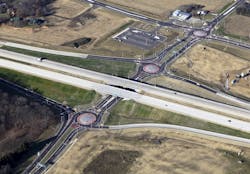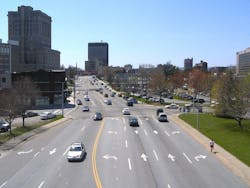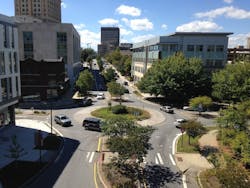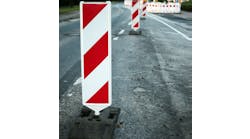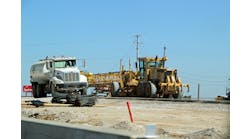A “roundabout” way to slash interchange cost and congestion while boosting safety
By: Ken Sides
Diamond interchanges are the most common interchange configuration, more common now than cloverleaf interchanges, which have a much larger footprint.
The traditional configuration for diamond interchanges has been for the four ramps to terminate at a pair of signalized intersections located closely on both sides of the interchange. But spacing signalized intersections closely together is problematic, because of insufficient room between them to store the back-to-back vehicle queues that are lined up to make left turns. Consequently, more signal green time must be taken away from through movements to give to left-turn movements, and so capacity of the intersections is ultimately limited, as are the benefits of coordinating signals along the arterial corridor. Worse, making room for those turn lanes can force the cost of an interchange span to almost double.
Freeway ramp junctions with arterial roads are excellent candidates for modern roundabouts at the terminus of the ramps, especially where there is a high proportion of left-turn traffic flowing from off-ramps or flowing onto the on-ramps. The modern roundabout is an alternative to signalized intersections that offers many attractions for interchange designers. Foremost among them is that modern roundabouts have no turn lanes.
For example ...
A typical signalized intersection in downtown Asheville, North Carolina, had 18 lanes connecting to the intersection, including five turn lanes, and operated inefficiently. Some of those connecting lanes were extra through lanes needed simply for storing through traffic queued at red lights. The downtown ambience suffered from the side effects of the poorly performing conventional intersection. The city of Asheville wanted a vibrant, more business-friendly downtown with less asphalt, more parking, more greenery, less air and noise from vehicles idling in queues, and a safer, more pleasant walking environment to restore street life and vitality. Asheville replaced the signalized intersection with a modern roundabout that has only eight connecting lanes. Now traffic flows freely most hours of the day, rush hour queues are shorter and mostly keep moving, and pedestrians have to cross only 14 ft at a time instead of crossing as many as six lanes. In Asheville, as elsewhere, modern roundabouts work well in mixed corridors having both roundabouts and signalized intersections.
Then there is the Rocky Mountain ski town of Vail, Colorado, which had a serious safety problem when weekend skiers would drive up I-70 from Denver in large numbers and exit the interstate only to come to a halt at the red light signals at the foot of the exit ramp terminus. Red light queues half a mile long would spill back up onto the interstate, creating a severe safety hazard, especially when visibility was poor and the road surface was slick. Residents rejected a $15 million design with longer overpass spans as lacking in bucolic charm. Instead, the ramp termini intersections were replaced with modern roundabouts, and the dangerous spillback queues vanished. The ramp termini roundabouts have proved to be equally highly efficient at the end of the day when the ski lifts close; tired skiers all need to get back onto I-70 for the long trip home, and the last thing they want is the usual traffic snarl that used to occur when the ramp termini were signalized intersections. Headway between vehicles exiting the roundabouts onto the on-ramp is more random than with vehicles exiting from a signalized intersection. Random spacing is better for the merge maneuver at the top end of the ramp into fast-moving traffic on the interstate. Interchange capacity increased by 56%, crashes with injuries decreased 75%, and with no more need for multiple police officers to direct traffic at the interchange, the city of Vail now saves more than $85,000 annually.
Risk reduction
When a major storm takes out traffic signals at interchanges, a dangerous situation quickly develops. With signals inoperative, the intersections operate very inefficiently, crashes are more likely, and intersection congestion causes vehicles arriving from the freeway to queue back, possibly spilling back up onto the freeway travel lanes. Police officers will have to be assigned to control traffic at the intersection. If the power is out at the intersection, power crews must work to restore it. If the signal heads are down or the signal controller cabinet is damaged, specialized signal crews will need to be dispatched to repair the equipment. All these resources must be diverted from where they are critically needed elsewhere post-storm. Because modern roundabouts need no power to function and thus pose no risk of equipment failure, they need no special attention after storms. In this regard, modern roundabouts are the most resilient form of intersection.
Seeing the Vail success, two other mountain towns, Avon and Eagle, soon followed with I-70 roundabout interchanges of their own. Avon voters overwhelmingly approved—by a 2:1 ratio—a property tax increase to pay for five new modern roundabouts, including two at an I-70 interchange. Realizing that roundabout central islands make ideal locations for public art, Avon and many other communities have placed sculptures and other artworks celebrating local community history and values in their roundabouts, as well.
Employing modern roundabouts at interchange ramp termini can save interchange designers from having to double the length or width of the interchange spans in order to accommodate turn lanes passing on or under the spans. A study for the Wisconsin DOT of proposed interchanges found that by using modern roundabouts, two of them would have only five lanes passing under the span instead of 10 lanes using signalized intersections. At two other interchanges, the number of underpass lanes was reduced from eight to four.
Life extension
Replacing signalized intersections with modern roundabouts can extend the life of existing interchanges by greatly increasing their capacity for traffic volume growth without the need to reconstruct the interchange structure. The single-point urban interchange (SPUI) is a configuration featuring a single set of signals located in the center of the intersection, usually hung from beneath the interchange spans, that control all turning movements. SPUIs can offer greater capacity than a traditional diamond interchange, but at the cost of very long spans because the intersection configuration is extremely wide. SPUIs can also be seen on the interchange span itself but at the cost of exceptionally large span surfaces. SPUIs can be quite costly to construct.
By teaming with designers of modern roundabouts, designers of future interchanges will not be forced to double the length of spans to accommodate turn lanes under the spans or to double the width of spans to make room for turn lanes situated on the spans. Other than the need for approaching drivers to have a good view or awareness of them, ramp termini roundabouts require no special design criterion different than modern roundabouts anywhere. Modern roundabouts perform very well in close proximity to each other, as well as in closer proximity to signalized intersections than the distances required between signalized intersections.
The city of Carmel, Indiana, realized that the benefits of roundabout interchanges were so compelling that it built an entire corridor of seven along 4 miles of Keystone Parkway, even lowering the parkway below grade to contain the noise of traffic in the service of quality of life. In fact, quality of life is the chief reason Carmel Mayor James Brainard cited for constructing 126 modern roundabouts in his city of 96,000—the highest density of modern roundabouts of any U.S. city.
Every year nearly 8,000 people die at conventional intersections in the U.S. By intrinsic design, head-on and T-bone crashes cannot occur at modern roundabouts, and vehicle speeds are very effectively kept low, typically under 25 miles per hour. Crashes that do occur at modern roundabouts are mostly low-speed, low-angle, low-energy crashes. A 2017 study by the Pennsylvania DOT found that modern roundabouts reduced both fatal and serious injury crashes by 100%, and minor injury crashes by 95%. Crashes are very costly: The Florida DOT calculates the comprehensive cost of a fatal crash to be $10.7 million and the cost of a serious injury crash to be $872,000. With no vehicles burning fuel while idling in red light queues, modern roundabouts typically show substantially reduced toxic and greenhouse emissions and are the most sustainable form of intersection. Currently there are more than 500 ramp termini roundabouts in the U.S. and almost a thousand worldwide. By including modern roundabouts in tandem with interchanges, engineering teams can create interchange designs with shorter, narrower, and less expensive spans that offer better performance and result in fewer incidents and fatalities.
About The Author: Sides is senior transportation engineer with Sam Schwartz Transportation Consultants.
